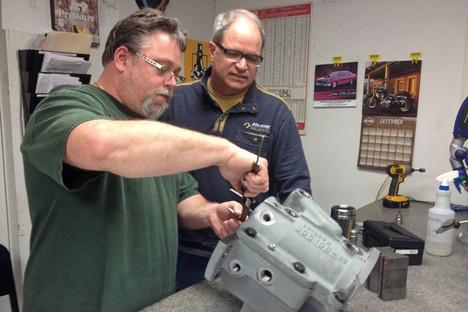 “Kevin Hartford, right, and a colleague at his factory. He started his business after employers failed to hire him.” Source of caption and photo: online version of the NYT article quoted and cited below.
“Kevin Hartford, right, and a colleague at his factory. He started his business after employers failed to hire him.” Source of caption and photo: online version of the NYT article quoted and cited below.
HR departments have incentives to avoid hiring risky employees. But a determined high-risk employee can hire themselves by becoming a free agent entrepreneur. If we want to truly help the disabled, we should remove obstacles to entrepreneurship, such as burdensome regulations and high taxation.
(p. B4) Mr. Hartford, the father of two sons, thrived as a business consultant in his 20s and 30s. He was used to flying first class, staying at swank hotels and advising CEOs. Then the consulting firm unraveled in the mid-1990s. When he began looking for a new job, a stuttering problem–something he had always considered manageable–put off potential employers.
“I applied for job after job after job,” says Mr. Hartford, now 58. “I was one of two finalists; I was one of three finalists. But I never got the job.”
In the end, Mr. Hartford concluded that his only shot at a satisfying job was to create a company. He is now president and co-owner of Alle-Kiski Industries, which makes parts, such as exhaust pipes for train locomotives and prototype truck wheels, for larger manufacturers, including Alcoa Inc. and General Electric Co.
Like many before him, Mr. Hartford discovered that one option for people who don’t fit into large organizations is to start a small one. That is particularly true for people with disabilities. About 11% of disabled workers are self-employed, compared with 6.5% of those with no disabilities, according to Labor Department data.
. . .
The business has grown to 38 employees from a dozen when Messrs. Hartford and Newell started in 2005. They own more than $2 million of equipment used to drill, groove and otherwise shape metal, arrayed in a 27,000-square-foot factory with an American flag hanging from one of the beams. Last year’s sales of $6 million were the highest yet, Mr. Hartford says, and the company is building a 4,000-square-foot addition to house more equipment.
For the full story, see:
JAMES R. HAGERTY. “Entrepreneur Let No Impediment Stop Him; Out-of-Work Consultant Started His Own Company After Discovering His Stutter Put Off Employers.” The Wall Street Journal (Thurs., Jan. 16, 2014): B4.
(Note: ellipsis added.)
(Note: the online version of the story has the date Jan. 15, 2014.)
